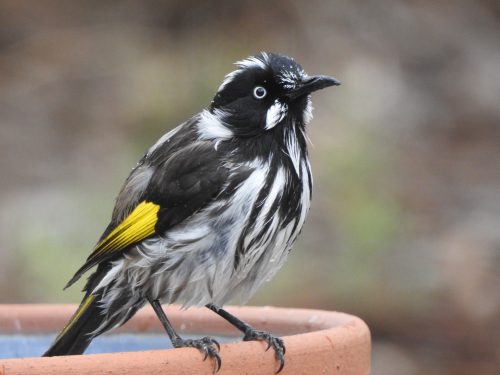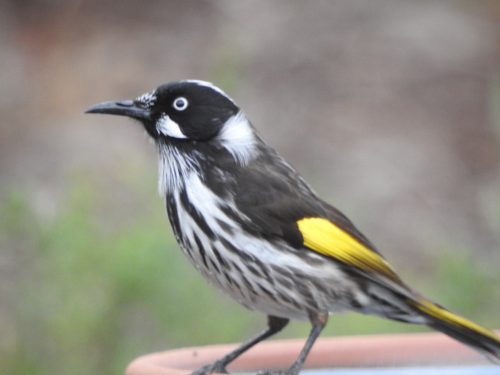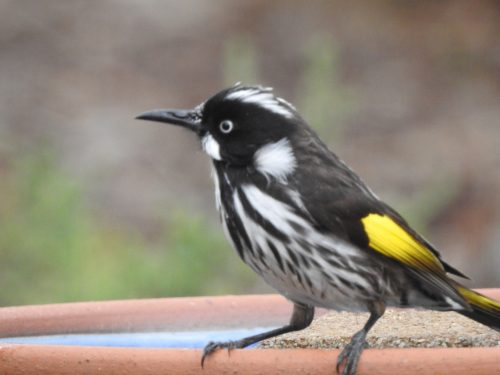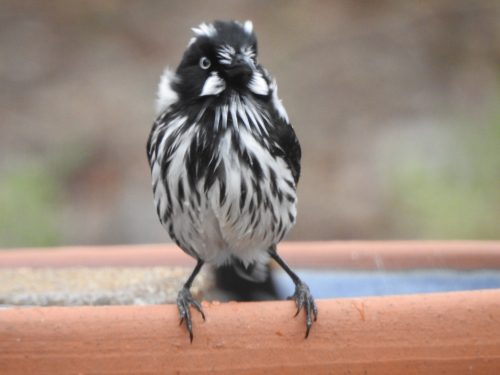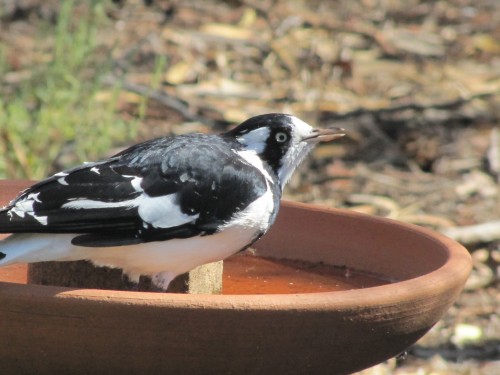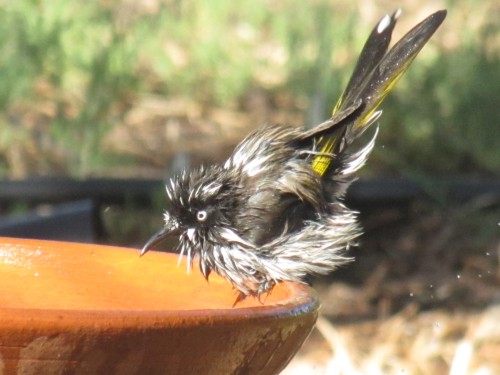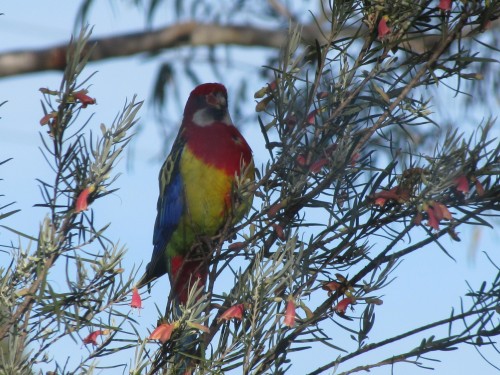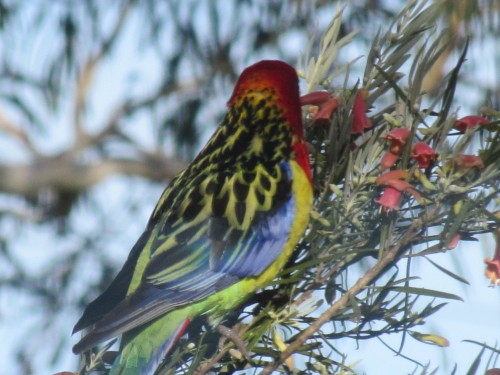New Holland Honeyeater posing
During the warmer months of the year, there is a constant stream of birds coming to my birdbaths for a drink. On hot days many of them will also come for a dip in the water. What always amuses me, however, is the number of birds which also come for a dip in the water on freezing cold days.
Some of the birds which regularly visit my birdbaths include 8 different species of honeyeaters, 3 kinds of parrots, Australian Magpies, Little Ravens, Grey Currawongs, White-browed Babblers, Superb Fairy-wrens, House Sparrows, Diamond Finches, Common Starlings, Grey Shrike-thrush, as well as at least 3 kinds of pigeons and doves and many other species. Over the years I have written articles and shown photos of most of these species. To find those articles just go to the search box above right or the Categories list on the right-hand side-bar. Or you could check out the archives section.
It is now winter here in Murray Bridge, South Australia, where I live. Over recent days we have had some very frosty mornings and cold nights. The water in the birdbaths is very cold and may even freeze on a night like tonight with the temperature due to go down to minus 1 degrees Celsius (30 degrees F). The birds will still be happy to have a drink during the day and even a short splash in the very cold water. I don’t think that I will be joining them in a hurry. They can enjoy it all to themselves.
Recently I took a series of photos (above and below) of a solitary New Holland Honeyeater enjoying the water. The individual was quite unhurried seeing it had the water all to itself. This is unusual because normally there would be anything up to a dozen birds or more, all splashing away happily and creating quite a noisy party with all of their excited calls.
Good birding,
Trevor
Keep the water coming
Summer has arrived here in South Australia. Already during spring we have had many days with temperatures over 30C (86F) and the forecast is for a hot, dry summer. In my home town of Murray Bridge we frequently get days over 40C (104F) and occasionally the thermometer soars to as high as 46C (115F).
Whatever the temperature in summer our birds often suffer from the extreme heat and hot searing north winds. On days of high temperature there is a constant stream of birds visiting our bird baths in our garden. They not only appreciate a drink, they often take a dip as well. On days of extreme heat their very survival depends on having access to water. The death rate during hot weather would be very high.
My advice would be to put out some dishes of water, or invest in a birdbath; there are many different styles available so check out your local garden centre or pet shop. Check the birdbaths every morning, replenishing the water as necessary. And don’t forget to scrub it clean once a week (but don’t use any detergent or other cleaning agents – just a brush will do).
Keep the water coming – your garden birds will love you – and keep coming back again and again.
See more photos here.
Get out of my patch
We normally have a few Mallee Ringneck parrots hanging around somewhere on our 5 acre property. In the last few years we have also had one Eastern Rosella keeping them company. We don’t see it every day but frequently enough to keep us happy – after all, it is a handsome looking bird.
This particular parrot has taken a liking to the flowers of several of our Eremophila youngii bushes – you can see the flowers in today’s photos. All the bushes have a pink carpet of flowers surrounding their trunks.
Earlier this week we were enjoying watching the rosella eating while we had our breakfast. A sudden flurry of flapping wings and snapping beaks and the parrot flew off at full speed – its tail closely pursued by an very aggressive Red Wattlebird which in turn was followed by a New Holland Honeyeater.
Both of these honeyeater species spend large proportions of their day also feeding on the flowers, so they seemed to be objecting to this interloper elbowing in on their patch. In reality, while both honeyeater species feed on this bush, neither tolerates the other for more than a few seconds. It is an all out territorial war.
And I forgot to mention that both honeyeater species are in breeding mode, so their tolerance level is at its lowest at this time of the year.
Further reading:
A moral dilemma – with a bird’s nest
Today I was faced with a moral dilemma.
I was trimming some bushes and branches with my chainsaw. This included a rather overgrown Boxthorn bush where it should not have been. I ripped into it with the saw, being careful not to get ripped into by the nasty spikes that cover boxthorn bushes. I managed to come away with only one scratch on my arm.
I had almost finished and straightened up to survey my work. A New Holland Honeyeater was going ballistic in the tree above me. Oh no, I thought. My worst fears were suddenly realised. I had partially removed a part of the boxthorn which contained a beautiful nest, complete with two eggs.
Here was my moral dilemma. The local council authorities insist I destroy all boxthorns on my property. My wife wanted the bush removed, and I wanted the nasty thing gone too. On the other hand, the wildlife authorities say that it is illegal to remove or destroy a bird nest.
In a piece of quick thinking I cut off the portion containing the nest. I then removed all of the offending bush. I placed the portion of the boxthorn containing the nest in the fork of the tree less than a metre from the original site of the nest (see photo above).
And I stood back to see to see what would happen. Within a minute the honeyeater was back on the nest. A great sigh of relief. I gave the nest a wide berth all afternoon until carefully taking the photos on this page. The shot below shows the bird still sitting on the eggs, watching me rather warily. (Click on the photo to enlarge the image – this will show the bird more clearly.)
The downside is that a little part of the garden will have to wait for the promised clean up for a few weeks. That’s not a problem – there’s plenty more to do elsewhere.
Singing Honeyeaters and native plants
The Singing Honeyeater is a common species in suitable habitat throughout much of Australia. It tends to be absent only from the eastern coastal areas, most of Victoria (except the south coast), and the far north of Queensland and the Northern Territory. It’s preferred habitats include mallee scrubs, mulga, roadside vegetation, orchards, vineyards and gardens. It tends to be rather solitary in habit. On occasions I have seen small loose flocks of up to four or five birds, usually where the vegetation is dense, for example, coastal dunes.
Resident Breeding species
The Singing Honeyeater is a resident breeding species in our garden. Their numbers never seem to go over about four or five on our 2 hectare (5 acre) block of land. The dominant plant species is mallee scrub (click here for a photo). They were perhaps more numerous more than ten years ago, but in recent times the New Holland Honeyeaters have become the dominant – and very bossy – species.
Updated November 2013
Eremophila glabra
The resident Singing Honeyeaters are regular visitors to our bird baths. I don’t think I’ve seen them actually bathing in the water; they just tend to come for a drink. Next to the bird bath is a sprawling bush called Eremophila glabra. In the photo this plant has the bright red tube-shaped flowers. (Click on the photo to enlarge). The honeyeaters frequently stay for five minutes or more feeding on these flowers. A quick return trip to the water for a drink and then they are off to feed elsewhere.
Dripper systems
In the photo you will observe a black hose in front of the bird. This is part of our watering system. We have installed many hundreds of metres of similar hoses throughout our garden and orchard. Wherever there is a plant we place a dripper. Each dripper then allows a steady stream of drips to the plant when the tap is turned on. We have timers on each tap which then turn off the water to the dripper hoses after a set time, usually one or two hours.
Severe drought
Many Australian gardeners have recently moved to this system because of the severe drought we are experiencing. Many areas are on severe water restrictions. In some places you cannot even use dripper systems like this one. We have certainly done our bit to conserve water because we’ve been using drippers for over 20 years. Most people are only installing them now.
Plants in our garden
For more photos and information about the plants in our garden and in our district go to Mallee Native Plants Nursery, my wife’s blog about our beautiful Australian plants.
